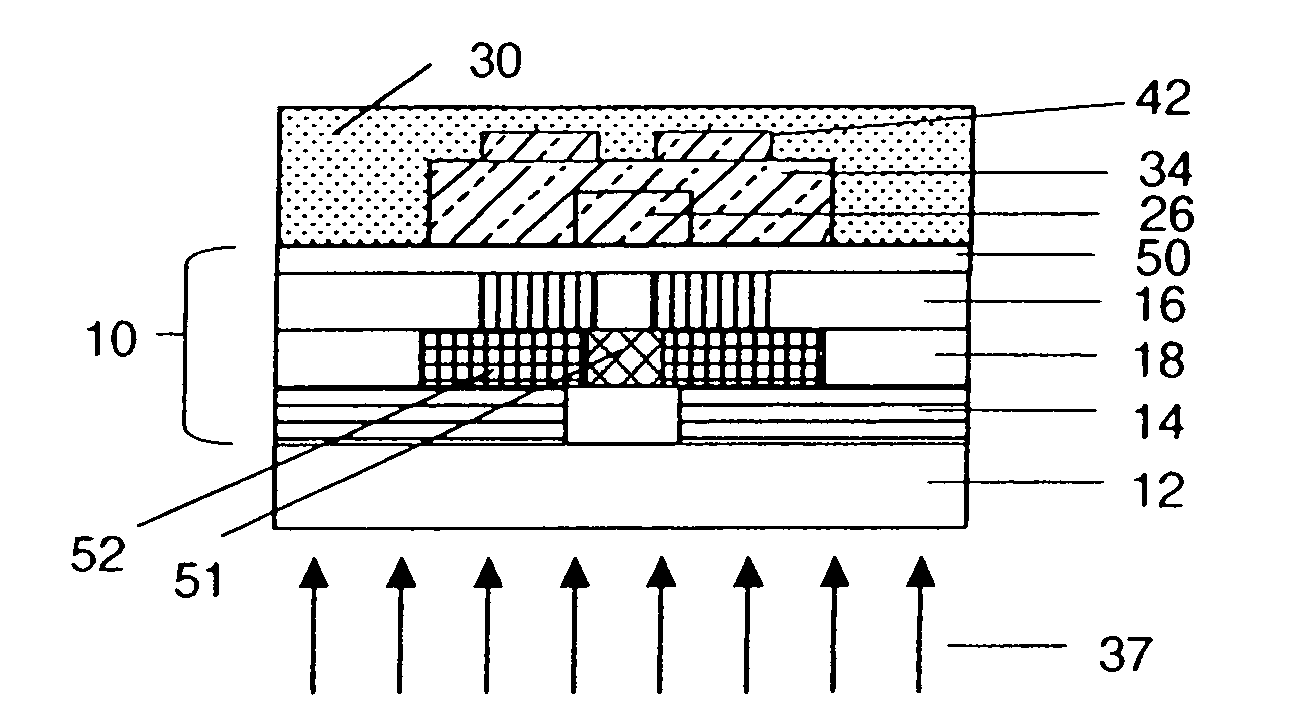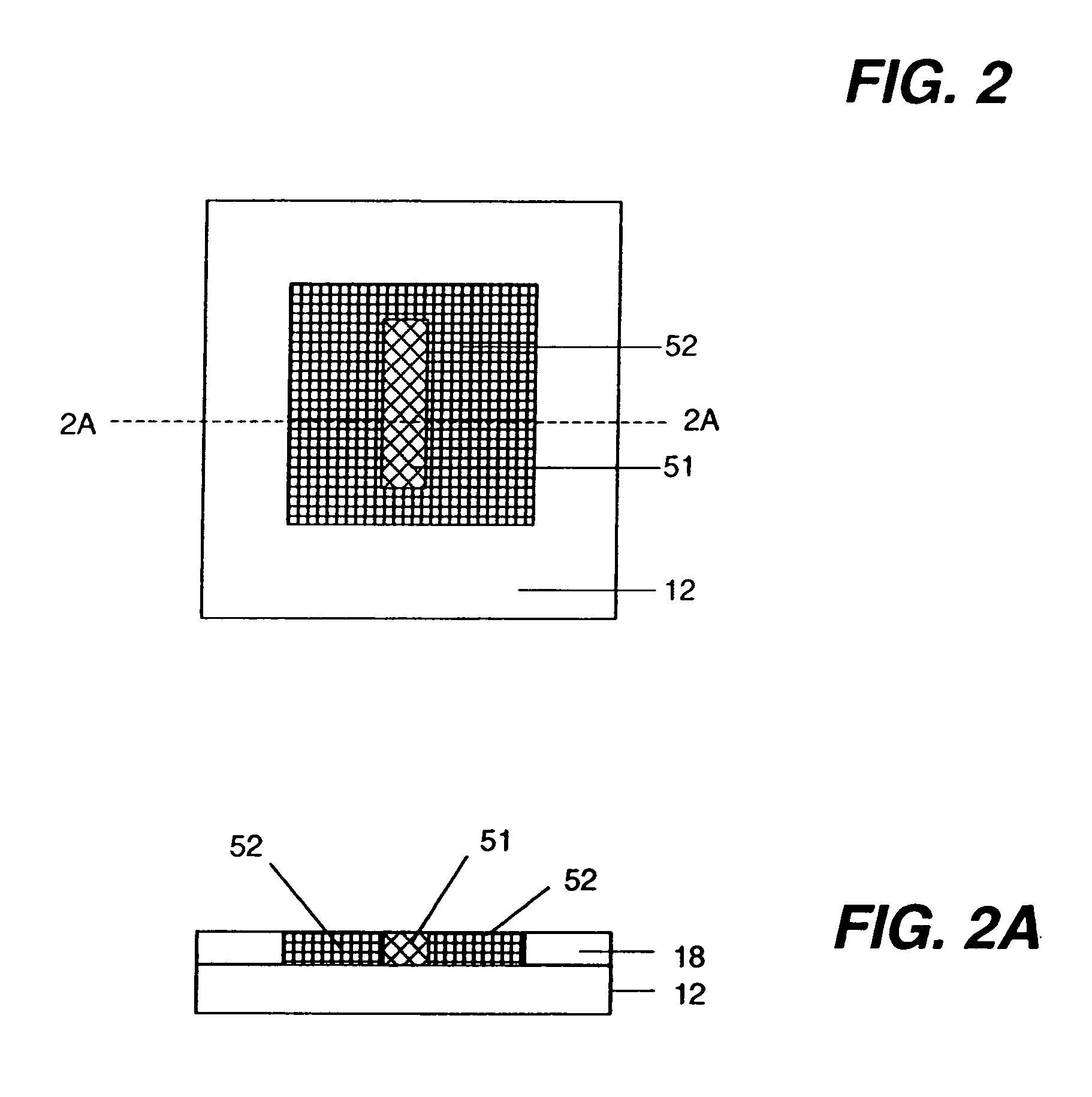Multicolored mask process for making display circuitry
a display circuit and multi-colored technology, applied in the field of multi-colored masking process for making display circuits, can solve the problems of affecting the performance and ability to perform alignment of transistor components, affecting the overlay accuracy achievable using traditional photolithography equipment, and applying multiple layers at extremely high speeds
- Summary
- Abstract
- Description
- Claims
- Application Information
AI Technical Summary
Benefits of technology
Problems solved by technology
Method used
Image
Examples
example 1
Colorscale Mask For Active Matrix Display
[0224]In this example, an active matrix multicolor mask AM-1 was prepared that contained the patterning information to create an array of pixel circuits for an active matrix display. A schematic diagram of the color absorbing layers for the multicolor mask is shown in FIGS. 17-20. Although the layout shown in FIGS. 17-20 is not drawn exactly to scale, the color-coding of the various components in the active matrix display design is consistent with the previous description. An expanded view of the color patterns in multicolor mask AM-1 for the individual active matrix display pixel circuit is also shown schematically in FIGS. 16A-D. Multicolor mask AM-1 contained red color absorbing layer RCA-1, green color absorbing layer GCA-1, a variable density blue-absorbing layer BCA-1 (an overlay of BCA-1Lo and BCA-1Hi patterns) and planarizing layer P-2. The four patterns in this mask corresponded to separate functional layers of the array of pixel cir...
example 2
Array of Active Matrix Display Pixel Circuits
[0229]In this example, an array of active matrix display pixel circuits was prepared using the multicolor mask AM-1 to pattern transparent electronic materials. The array of pixel circuits were prepared on the same side of the substrate as the multicolor mask.
[0230]The first conductor layer was patterned using a negative etch process and red-sensitive photopatternable material. The sample was coated with 1000 Angstroms of sputtered indium-tin-oxide, which was used as the first conductor layer, applied directly over the planarizing layer P-2. A coating solution was prepared containing 4 g of CF-1 and 0.5 g of the photoinitiator solution CPI-1. The coating solution was spin coated at 2000 RPM for one minute and dried for 2 minutes at 90° C. A 10% PVA coating was applied at 1000 RPM for 2 minutes and dried at 90° C. for 2 minutes. The coating was exposed using red light in such fashion that exposing light passed through the glass support and...
example 3
Array of Active Matrix Display Pixel Circuits on Flexible Support
[0235]In this example, an array of active matrix display pixel circuits was prepared using a multicolor mask AM-2 to pattern transparent electronic materials on a 100 um thick flexible (PEN) support. The display pixel circuits were prepared on the opposite side of the substrate as the color mask. The color absorbing layers in AM-2 had essentially the same layout as for multicolor mask AM-1. A schematic diagram of the color absorbing layers for the multicolor mask is shown in FIGS. 17-20. Although the layout shown in FIGS. 17-20 is not drawn exactly to scale, the color-coding of the various components in the active matrix display design is consistent with the previous description. An expanded view of the color patterns in multicolor mask AM-1 for the individual active matrix display pixel circuit is also shown schematically in FIGS. 16A-D.
[0236]The first step in fabricating the array of display pixel circuits was to pre...
PUM
| Property | Measurement | Unit |
|---|---|---|
| transparent | aaaaa | aaaaa |
| color | aaaaa | aaaaa |
| optical densities | aaaaa | aaaaa |
Abstract
Description
Claims
Application Information
 Login to View More
Login to View More - R&D
- Intellectual Property
- Life Sciences
- Materials
- Tech Scout
- Unparalleled Data Quality
- Higher Quality Content
- 60% Fewer Hallucinations
Browse by: Latest US Patents, China's latest patents, Technical Efficacy Thesaurus, Application Domain, Technology Topic, Popular Technical Reports.
© 2025 PatSnap. All rights reserved.Legal|Privacy policy|Modern Slavery Act Transparency Statement|Sitemap|About US| Contact US: help@patsnap.com



